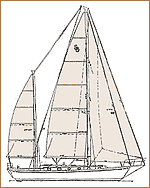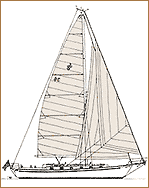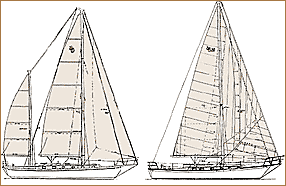SHANNON SAIL TECHNOLOGY
as the wind rises by reducing to a staysail. The reasoning behind the rig tends to frustrate tradionalists unreceptive to how it improves upon either of the two
schemes that comprise its name, but in a word, it works."
-Quentin Warren, SAILING, January 2000
The Scutter and Sketch rigs offer a variation on the double headsail theme. In 1994 Walt Schulz developed the Scutter to reflect the combination of the fore triangle plan of a double headsail sloop and the mainsail of a cutter as an alternative rig for all Shannon models. On a conventional sloop, a 140% genoa cannot be reefed down with a roller furler to much less than 110% and still power the boat. A rolled up genoa loses its shape which compromises its structural integrity, and consequently has no efficiency when reduced more than 30%. Roller furling a large genoa is no substitute for a true working jib in heavy winds. A single headstay boat requires a headsail change when winds increase creating dangerous foredeck work at the worst time. By contrast, the Scutter rig keeps the boat sailing well in a wide range of wind speeds, without putting the crew in harm's way making sail changes


Another feature of the Scutter rig is that the center of effort on the headsails moves forward as the sails are furled, which will reduce the weather helm typically encountered on other boats in the higher wind ranges. The Scutter rig also incorporates a mast head crane resulting in the relocation of the back stays further aft. This allows for 15% more roach in the fully battened mainsail, enabling the Scutter to sail to windward reasonably well without the use of headsails. By eliminating the dependency on large overlapping genoas the Scutter rig requires much less winch work sailing to windward than a sloop. The features of the Scutter can be combined with the addition of a fully battened mizzen for a Sketch rig, with endless possibilities for the cruising sailor. Nearly every Shannon owner since 1994 has ordered a Sketch or a Scutter
Similar to the Scutter and the Sketch, Shannon cutters and ketches are rigged with double headsails for ease of handling and a variety of different sail combinations depending on the weather. The classic cutter rig has twin side-by-side forestays on the bow platform that can accommodate both a yankee and a large genoa either roller furled or conventionally hanked on.
Coming inboard, just aft of the actual stemhead is the staysail which is available either loose footed or on a self-tending club boom sheeted to the cockpit. The staysail is an excellent heavy weather sail. Thus, three sails are carried forward of the mast ready to go as wind conditions change without having to drag a jib out of a cockpit sail locker. The twin headstays on the bow platform also allow for excellent wing-and-wing sailing with two jibs in the trade winds.

Some boats feature internal mast furling or stow-away mainsails, a necessity due to their tall sloop rigs. For a variety of reasons, primarily related to inefficient main sail shape and equipment reliability problems, Shannon does not recommend internal mast furling mainsails. To give the same ease of handling as a stow-away system, the Shannon 43 can be equipped with the main halyard and continuous reefing lines lead aft to the cockpit. With the installation of an electric self-tailing winch, mast track and cars, full length battens, line stoppers and lazy jacks, raising the main and putting in reefs can all be accomplished from the cockpit with the same ease as a stow-away system. The Shannon reefing option has the advantage that if any component of the this system fails, the sail can still be lowered, and reefs put in the old fashioned way. However, stowaway mainsails are available at owner request.